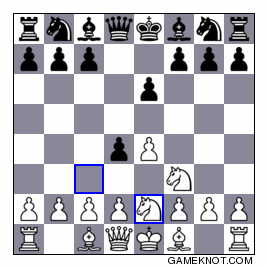 Below are some of the main positions explored in the Jackal Attack e-book. You can download a trial copy by clicking here . Alternatively; go to the jackal website where you will find the 'message in a bottle' image. The book can be downloaded by clicking on the picture at the site. The book will partially open; giving an idea of the layout and method of analysis.
Below are some of the main positions explored in the Jackal Attack e-book. You can download a trial copy by clicking here . Alternatively; go to the jackal website where you will find the 'message in a bottle' image. The book can be downloaded by clicking on the picture at the site. The book will partially open; giving an idea of the layout and method of analysis.An infrequently played variation in the Jackal: Black plants the knight into e4 and usually follows up with ...Bc5; momentarily threatening mate.
After d4 Be7 the knight will not be harassed by White's d-pawn - but can later come under pressure from White's minor pieces.
See Sections A1-A5 in the e-book.
A main line position: White ignores the the pressure that will soon be brought to bear on his pawns on b2, e5 and f2. He will instead rely upon his superiority in development and space to create dynamic threats. As the e-book demonstrates - there is no known refutation of the Jackal Attack.
See Sections D1- D15 in the e-book.
This is known as the Belfast Variation - a line where two of the above - mentioned pawns have been captured. It's a risky business:
It is Black to move and he is about to capture the rook. Interestingly, strong chess programs will assess this as clearly winning for Black. Far from it - Black will do well if he can even draw.
See Section D1 in the e-book.
Only the f-pawn has been targeted on this occasion. Black has emerged with his extra pawn whereas White has the bishop pair in the sort of position that is likely to favour them.
Opposite side castling will result in sharp play.
Opposite side castling will result in sharp play.
See Sections D7-D9
An entirely different variation referred to in the e-book as the Lebel Variation; named after the detective in the book 'Day of the Jackal'.
Driving the pawn deeper into White's territory initially confers a slight space advantage to Black. However, it is now his centre that tends to come under scrutiny.
Sections E1-E8 in the e-book.
 Black goes for a much more open position right from the outset. This changes the prospects of his light squared bishop - a piece that usually finds itself hemmed-in in the French Defence. But White's development is already noticeably better - and this is a drawback for Black who may also be soon left with an isolated d-pawn. Sections F1-F3 in the e-book are relevant.
Black goes for a much more open position right from the outset. This changes the prospects of his light squared bishop - a piece that usually finds itself hemmed-in in the French Defence. But White's development is already noticeably better - and this is a drawback for Black who may also be soon left with an isolated d-pawn. Sections F1-F3 in the e-book are relevant.




